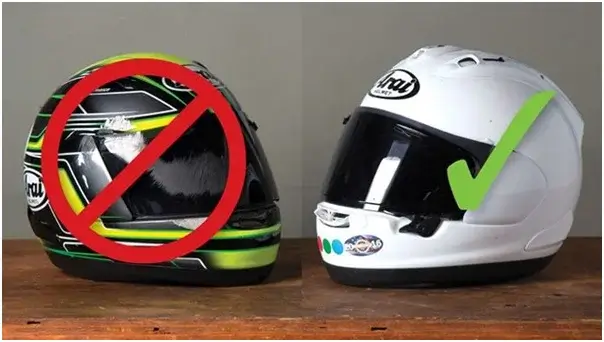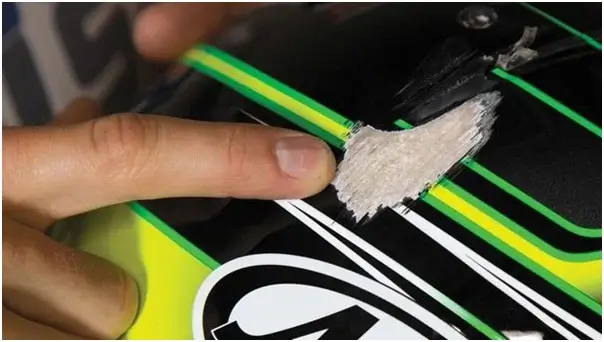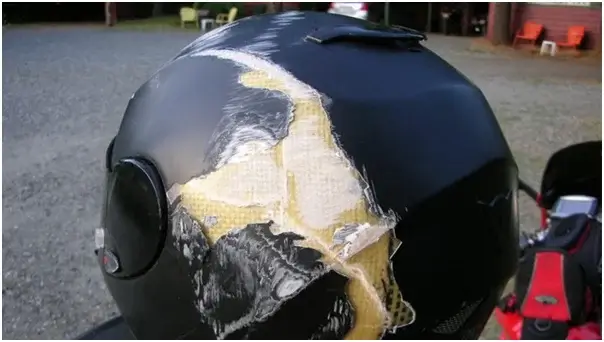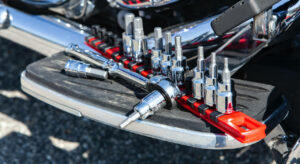There is an unspoken rule that recommends changing a motorcycle helmet every five years, it is also recommended to replace the helmet if it accidentally falls off, let’s see if this is true. The biggest myth if a motorcycle helmet falls, for example, on a parked motorcycle or just falls out of your hands, it should be replaced.
Can you imagine someone throwing away a $500-$600 Arai or Shoei helmet just because it slipped out of their hands onto the pavement? Of course, after a fall you should check the helmet for cracks and chips and it will depend on how hard it fell and helmet types.

If your helmet has had a fall or a lot of impacts, but you do not visually see any damage, but you are still worried about them, then it is better to look for a new helmet to replace it. Even though motorcycle helmets are quite reliable (of course, certified helmets) they are considered disposable products, which are designed to protect the head, if you collide or fall off the bike and after an accident, they will need to be replaced.

However, most quality motorcycle helmets can withstand the light impact they receive in everyday use without any damage, but that does not mean they can be used carelessly. If a helmet does not meet minimum safety requirements and is not certified to ECE, DOT, or SNELL standards, then you have to wonder if it will even protect the rider in an accident. You should treat your helmet with care and keep it in a cool, dry place and never store anything heavy inside it. If your helmet falls with a heavy object inside it might deform the absorption layer inside.
Suggestion: List of Self Driving Cars Pros And Cons – How Self Driving Cars Work?
Helmet age, damage, and natural wear and tear can affect its full protection. Helmet materials deteriorate gradually under the influence of the environment (sun, rain) and lose their protective qualities, so the general service life of helmets made of ABS plastic or polycarbonate lasts about five years and about seven years is the service life of composite helmets. Also, the helmet liner loses its effectiveness over time and becomes unusable.
Store your helmet in its case in a cool dry place when not in use.
The primary purpose of a helmet is to protect the rider’s head in an accident, so make sure that your motorcycle helmet is as prepared for the season as your motorcycle is before preparing for the new motorcycle season. Inspect the outer shell of your helmet for cracks, dents, deep scratches, or other signs of damage. You may have never dropped or fallen in your helmet, but that doesn’t mean that someone else didn’t accidentally knock it off the shelf and tell you about it, so give it a thorough external inspection. Don’t buy a used helmet
off-hand, since you don’t know how old it is or how it’s been used.
Popular For You: Buy Best Car Speakers For Bass And Sound Quality at Online
Remove the soft liner and check its condition, because frequent head sweat gradually destroys the lining, in addition, over time the lining wears away and becomes looser. Wash or replace the lining if necessary. You can extend the life of the lining by wearing a balaclava cap on your head, so the liner will need less washing.
When you have removed the liner, check the inner EPS layer of the helmet for damage, if the foam has dents or cracks, then most likely such a helmet has been subjected to a blow and can no longer be used. The chin straps wear out during frequent use, so check carefully the attachment of the straps to the D-rings or the micrometric latch. Check the helmet visor for scratches and cracks that may obstruct your view and make sure the glass is firmly in place and opens and closes properly. Check and tighten the screws of the hinge mechanism for the visor.
How do I extend the life of my helmet?

- Don’t wear it with the visor open so as not to damage the seal. Close the visor completely for storage and wear your helmet by the strap.
- Don’t glove in your helmet to keep dirt and bacteria out. Also, the Velcro closure on the gloves will cling to the lining fabric and fluff it up.
- Don’t hang your helmet on a mirror – dust and dirt accumulate on it, including road chemicals that seem to be able to ruin any material at all.
- Don’t put your helmet on the tank to avoid petrol fumes. It degrades the properties of the helmet’s polystyrene foam filler, and can also soften the shell.
- Do not put your helmet on the seat. It can fall over even from a passing bus nearby, and the neighborhood kids and cats will help.
- If you need somewhere to put your helmet temporarily, and hanging it on the grip is not an option, just put gloves on the ground and put your helmet on them.
Conclusion
Do not forget that a certified motorcycle helmet is not only a guarantee of safety, but also comfort, good aerodynamics, sound insulation, ventilation, and it is important good visibility. And finally, another reason why it is recommended to replace the old helmet with a new one after five years of service. This is because modern motorcycle helmet technology and materials are constantly improving and the new, modern motorcycle helmet, will offer a
higher level of protection and comfort than the helmet of five years ago. Also, it will be implemented many additional convenient features that help the rider feel full protection and comfort when riding a motorcycle.




